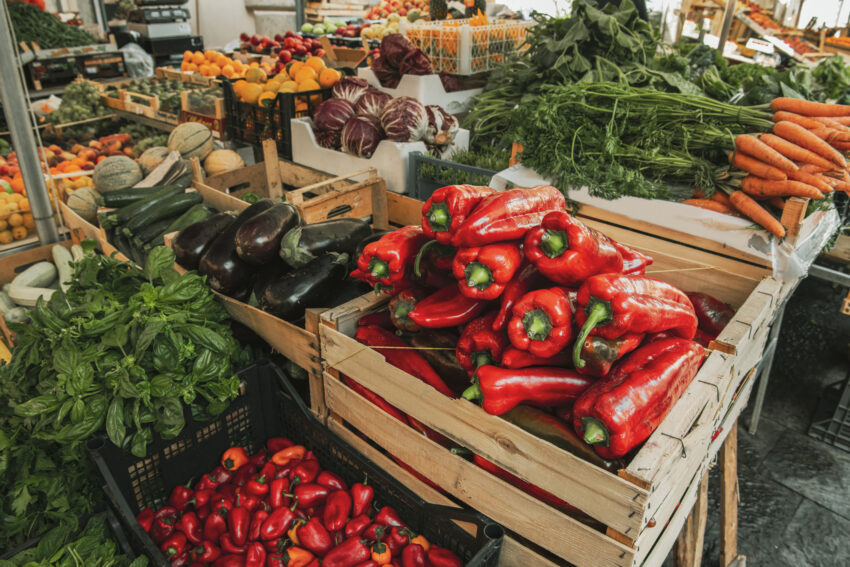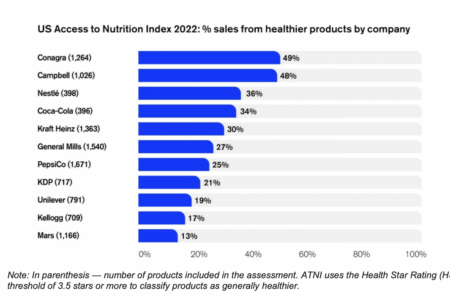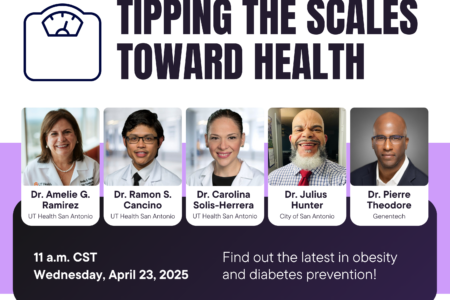
Share On Social!
The nation’s largest food and drink companies are “not making adequate progress” on their promises to make, market, and sell healthy food and drinks, according to the the U.S. Access to Nutrition Index 2022.
The index, published by the Access to Nutrition Initiative (ATNI), evaluates the companies’ on the healthiness of their products and their nutrition-related commitments, policies, and disclosures.
None of the 11 largest companies had more than 49% of sales from healthier products.
“While all companies have placed a greater focus on nutrition in their corporate strategies since the first index was released in 2018, their actual products have not become healthier, and they are not making sufficient efforts to safeguard children from the marketing of unhealthy products,” according to an ATNI press release.
How does this lack of healthy food access impact Latinos?
What Foods and Drinks Are Companies Promoting?
The 11 largest food and drink companies sold $170 billion worth of products in 2021.
Less than one of every three products sold (30%) meets a “healthy” threshold, according to the index. More than two of every three products sold (70%) are less healthy with higher levels of added sugar, salt, and fat and not enough fruit, vegetables, whole grains, and fiber.
Here are the companies’ percentage of sales from healthier products:
- Conagra, 49%
- Campbell, 28%
- Nestle, 36%
- Coca-Cola, 34%
- Kraft Heinz, 30%
- General Mills, 27%
- PepsiCo, 25%
- KDP, 21%
- Unilever, 19%
- Kellogg, 17%
- Mars, 13%
The index did have a little good news.
Companies’ percentages of healthier foods sold improved – albeit slightly – in 2022 over 2018.
Also, four companies, compared to only one in 2018, showed evidence of taking action to improve the affordability and accessibility of healthier products via commercial channels.

“All companies incorporated a greater focus on nutrition and health in their commercial strategies. But only a few have translated these commitments into concrete action plans that focus on addressing the needs of population groups at higher risk of experiencing nutrition challenges, such as families with low incomes,” according to an ATNI press release.
“Commercial access and affordability of their healthier products remains a low priority for companies.”
What Does Healthy Food Access Mean for Latinos?
The index has big implications for US Latinos.
This population, which comprises 18.9% of the nation, already struggles with healthy food access, food and nutrition insecurity, and exposure to abundant junk food.
Healthy food access. Fast food restaurants and corner stores are easily accessible in in many Latino neighborhoods. On the other hand, Latino neighborhoods have one-third fewer grocery stores and fewer farmer’s markets than non-Latino ones, according to a Salud America! research review. This results in overconsumption of unhealthy foods, and more risk of obesity.
Food and nutrition security. Nearly 1 in 5 Latinos not having enough access to food. Many of the same Latinos that experience food insecurity also experience nutrition insecurity, which includes access, availability, and affordability of foods and beverages that promote well-being.
Exposure to junk food. The fast-food industry spent $5 billion on advertising in 2019. Advertising for unhealthy food continue to target Latino and Black youth. For example, eight out of 10 food ads seen by Latino children on Spanish-language TV promote fast food, candy, sugary drinks, and snacks.
The access to and promotion of unhealthy products is harmful to the Latino population, said Dr. Amelie G. Ramirez, leader of Salud America! at UT Health San Antonio.
“If the industry really values these consumers, companies will take responsibility for advertising that encourages poor diet and related diseases. They can start by eliminating the marketing of unhealthy products to Hispanic youth and families,” Ramirez said.
What Can Companies Do for Healthier Food Environments?
The new index comes with some sweeping recommendations for
sector-wide transformation to improve the nutritional quality of the US food supply.
ATNI urges companies to benchmark their definition of “healthy,” define targets for increasing the sale of healthy products, and report on their progress annually.
ATNI also suggests companies:
- Develop comprehensive strategies to improve the overall nutritional quality of products, including prioritizing marketing spending for healthy products.
- Commit to marketing that aligns with the International Chamber of Commerce marketing framework, widen the media channels to which policies apply, and explicitly address in-store/point-of-sale and sponsorship marketing in policies.
- Improve marketing policies and practices to accelerate sales of healthy options relative to and limiting the sales of unhealthier products/product varieties, including further increasing the age threshold for their marketing restrictions to 18 years, as recommended by the World Health Organization (WHO).
- Disclose trade association memberships in the US, including the specific dues paid that are used for lobbying purposes and any board seats held at these organizations.
- Extend workforce nutrition programs to all employees and their families. Only Kellogg, PepsiCo, and Unilever had all three in place.
- Adopt an easy-to-understand front-of-pack labeling system and use updated nutrition criteria for the “healthy” claim on packages.
- Support and refrain from lobbying against public policy measures that improve public health and address obesity.
“With food and nutrition insecurity being a major challenge in the US, it is crucial that companies go beyond federal assistance programs and charitable donations and adopt strategies to increase the commercial accessibility and affordability of their healthy products to those population groups most in need,” according to the index.
What Next Steps for Healthy Food Access?
In addition to the company-level recommendations, the federal government is increasing its attention on healthy food access across the US.
In September 2022, the Biden Administration hosted a White House Conference on Hunger, Nutrition, and Health, announcing the goal to eliminate hunger in America, improve diet and physical activity, and reduce diet-related disease by 2030.
They also released a national strategy with five pillars:
- Improve food access and affordability.
- Integrate nutrition and health.
- Empower all consumers to make and have access to healthy choices.
- Support physical activity for all.
- Enhance nutrition and food security research.
Federal food aid programs, such as SNAP and WIC, continue to be updated for nutritional improvements, although progress is slower on the Dietary Guidelines for Americans.
Also, in September 2022, the White House announced more than $8 billion in private- and public-sector commitments.
“Each of these commitments demonstrates the tremendous impact that is possible when all sectors of society come together in service of a common goal. The Biden-Harris Administration looks forward to working with all of these extraordinary leaders and to the many more that will come forward to end hunger and reduce diet-related disease by 2030,” according to the White House.
How Can You Get Involved in Improving Nutrition and Food Access?
What does food security and nutrition look like in your community?
Find out with the help of Salud America’s Health Equity Report Card!
Select your county and see details regarding food and nutrition including:
- food access
- percentage of population with SNAP Benefits
- grocery store rate
Email your Health Equity Report Card to community leaders, share it on social media, and use it to make the case to address food and nutrition insecurity where help is needed most!
GET YOUR HEALTH EQUITY REPORT CARD!
Explore More:
Healthy FoodBy The Numbers
1
Supermarket
for every Latino neighborhood, compared to 3 for every non-Latino neighborhood



